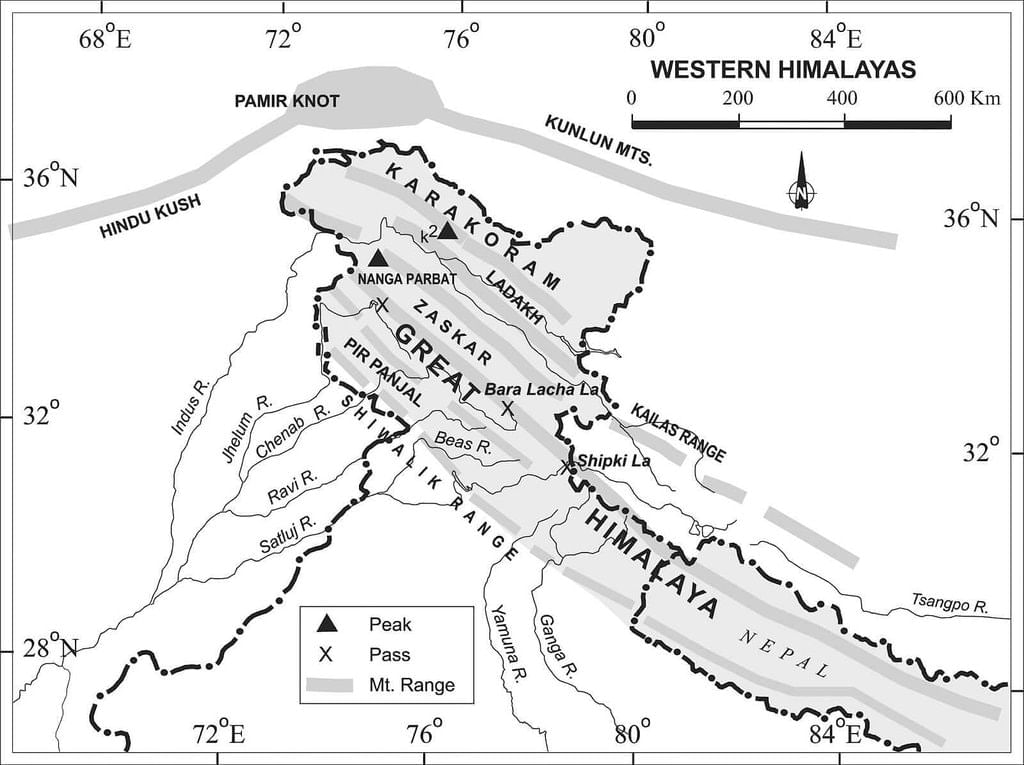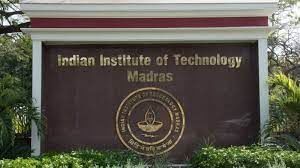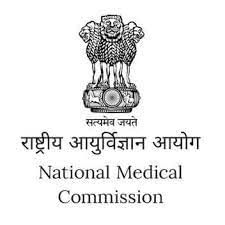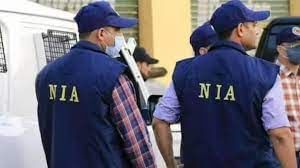UPSC Daily Current Affairs- 20th May 2023 | Current Affairs & Hindu Analysis: Daily, Weekly & Monthly PDF Download
GS-I
Himalayan Ranges
Why in News?
Militant activity has claimed more casualties in the Pir Panjal valley than in the Kashmir valley this year
About Important Himalayan Ranges
- The Himalayas, or Himalaya is a mountain range in Asia, separating the plains of the Indian subcontinent from the Tibetan Plateau. The Himalayas abut or cross five countries: Bhutan, India, Nepal, China, and Pakistan.
- The Himalayan range is bordered on the northwest by the Karakoram and Hindu Kush ranges, on the north by the Tibetan Plateau, and on the south by the Indo-Gangetic Plain. Some of the world’s major rivers, the Indus, the Ganges, and the Tsangpo–Brahmaputra, rise in the vicinity of the Himalayas.
- Characteristics of Himalayan ranges
- It is composed of a series of several parallel or converging ranges.
- The ranges are separated by gorges and deep valleys creating a highly dissected and hog back topography.The southern slopes have steep gradients and the northern slopes have comparatively gentler slopes.
- The ranges are dissected by several passes that provides the critical transportantation and communication links. Major are Banihal, Zoji La, Nathula la, Khardung La etc
- The important divisions of Himalayas include
- The Trans Himalayas – Tibetan Himalayas
- The Greater Himalayas
- Lesser or Middle Himalayas
- Shiwaliks or Outer Himlayas
- The Easter Hills- Purvanchal Himalatayas
The Trans Himalayas
- Trans-Himalayas, eastward continuation of the most northerly ranges of the Himalayas in the southern part of the Tibet Autonomous Region of China.
- The Trans-Himalayas, mainly composed of granites and volcanic rocks of Neogene and Paleogene ag
- It is bounded by the Kailas (southwest), Nganglong Kangri (north), and Nyainqentanglha (southeast) mountain ranges and by the Brahmaputra (Yarlung Zangbo) River (south).
- Northern slopes of the range are extremely rugged
- The southern slopes also are comparatively well watered, and the natural environment is clearly divided into vertical zones, rich in grasses and shrubs affording good mountain pastures.
- The southern slopes drain into the Yarlung Zangbo River, the name in China for the Brahmaputra
The Greater Himalayas
- It is the highest and northernmost section of the Himalayan mountain ranges.
- It extends southeastward across northern Pakistan, northern India, and Nepal before trending eastward across Sikkim state (India) and Bhutan and finally turning northeastward across northern Arunachal Pradesh state (India); throughout nearly all of its length it adjoins to the north the southern Tibet Autonomous Region of China.
- The range’s total length is some 1,400 miles (2,300 km), and it has an average elevation of more than 20,000 feet (6,100 metres).
- The Great Himalayas contain many of the world’s tallest peaks, including (from west to east) Nanga Parbat, Annapurna, Mount Everest, and Kanchenjunga
- Assam Himalayas, eastern section of the Great Himalayas, extending eastward across Sikkim state (India) and Bhutan, into northern Assam and Arunachal Pradesh states (India), and along the border with the Tibet Autonomous Region (China).
- The mountains run eastward for 450 miles (720 km) from the upper Tista River in the west to the great southward bend of the Brahmaputra River (there called the Tsangpo River) in the east.
Lesser Himalayas
- Lesser Himalayas, also called Inner Himalayas, Lower Himalayas, or Middle Himalayas, middle section of the vast Himalayan mountain system in south-central Asia.
- The Lesser Himalayas extend for some 1,550 miles (2,500 km) northwest-southeast across the northern limit of the Indian subcontinent. Areas include the disputed Kashmir region (Gilgit-Baltistan, administered by Pakistan, and Jammu and Kashmir union territory, administered by India), the Indian states of Himachal Pradesh and Uttarakhand, Nepal, the Indian state of Sikkim, and Bhutan.
- The range lies between the Great Himalayas to the northeast and the Siwalik Range (Outer Himalayas) to the southeast and has an average elevation of 12,000 to 15,000 feet (3,700 to 4,500 metres).
- It includes portions of the western (Punjab), Kumaun, Nepal, and Assam Himalayas ranges
Shiwaliks- or Outer Himalayas
- extends west-northwestward for more than 1,000 miles (1,600 km) from the Tista River in Sikkim state, northeastern India, through Nepal, across northwestern India, and into northern Pakistan.
- Nepal’s portion of the range is called the Churia Range.
- It rises abruptly from the plain of the Indus and Ganges (Ganga) rivers (south) and parallels the main range of the Himalayas (north), from which it is separated by valleys.
- Everywhere in this section the poor scrub forests have long since been removed, and the hills are subject to severe erosion. Seasonal torrents, called cos, sweep masses of sand and silt down into ever-changing great streambeds that are dry except after rains.
The Eastern Himalayas
- The Purvanchal Hills are a range of hills in northeastern India, located in the states of Assam, Arunachal Pradesh, and Nagaland. The name “Purvanchal” means “eastern mountains” in Hindi and refers to the region’s location to the east of the Ganges River.
- The Dafla Hills, Patkai Hills, and Mishmi Hills are some of the major ranges within the Purvanchal Hills.
Kashmir Valley
- It is an intermontane valley, western Jammu and Kashmir union territory, northern India.
- Lying wholly within the Indian-administered portion of the Kashmir region, it is flanked by the main range of the Himalayas on the northeast and the Pir Panjal Range on the southwest.
- The Vale of Kashmir is an ancient lake basin about 85 miles (135 km) long, 20 miles (32 km) wide, and 5,300 feet (1,620 metres) high that is drained by the upper Jhelum River.
- The population of the Kashmir region is concentrated in the valley, at the centre of which lies Srinagar, the summer capital of Jammu and Kashmir. The fertile alluvial soil yields rice, corn (maize), fruit, and vegetables, and the scenic mountains and lakes (notably Wular, Dal, and Nagin) attract many tourists.
Source: The Hindu
Kohinoor

Why in News?
A Parliamentary Standing Committee deliberating on heritage theft has noted that Kohinoor diamond should be returned by the U.K. to India.
Kohinoor
- Kohinoor, meaning ‘Mountain of Light’, Kohinoor is a colourless diamond.
- It is one of the largest cut diamonds in the world, weighing 105.6 carats.
- The diamond is currently set in the Crown of Queen Elizabeth The Queen Mother.
History of Kohinoor
- It is believed to have been first mined in the 13th century, near Guntur in Andhra Pradesh by the Kakatiya dynasty.
- Over the years, the jewel got passed on to the Delhi Sultan Alauddin Khilji and then to the Mughal empire following which Persian invader Nadir Shah took it to Afghanistan.
- It passed through different dynasties before reaching Ranjit Singh, the Sikh Maharaja of Punjab, in 1809, who ruled from Lahore.
- The diamond was eventually acquired by Queen Victoria in 1849, following the second Anglo-Sikh war, during which Punjab was brought under the East India Company. The diamond was taken by the British after the signing of the Last Treaty of Lahore.
- Under the British Raj, the diamond underwent a major recutting as the original Kohinoor had failed to appeal to viewers in London, shaping it into the present form.
Claims
- Multiple former territories of the British Raj - India, Pakistan and Afghanistan - have laid claim to the diamond. India first laid claim to it after independence in 1947 and multiple requests were made since then.
- The death of Queen Elizabeth II, Britain's longest-reigning monarch, reignited the demand in India to bring back the Kohinoor.
Arguments against
- All these claims were rejected by the U.K. In 2010, then-UK PM David Cameron rejected the notion of returning the Kohinoor, saying: "If you say yes to one, you suddenly find the British Museum would be empty."
- If India could lay claims on the diamond, then so could a number of other countries like Iran and Afghanistan.
- Other objects of loot from India like the Darya Noor (which is a sister diamond of Kohinoor) and parts of the Peacock throne are in Iran, but nobody speaks about it.
Can it be returned to India?
- India does not have legal competence to demand the return of the diamond. Under the Antiquities and Art Treasure Act, 1972, the Archaeological Survey of India can retrieve only such antiquities that have been illegally exported out of the country.
- The case of Kohinoor is contentious since it was surrendered by Maharaja Dalip Singh as part of the 1849 Lahore treaty with the British.
- The Ministry of Culture filed its affidavit in 2016 in the Supreme Court, where it had said that the diamond cannot be reclaimed as it was given as a gift.
UNESCO Convention of 1970
- The UNESCO 1970 Convention on the Means of Prohibiting and Preventing the Illicit Import, Export and Transfer of Ownership of Cultural Property is an international treaty to combat the illegal trade in cultural items.
- A combined reading of Articles 7 and 15 of the convention indicates that the convention does not prevent state parties from entering special agreements for the restitution of removed cultural properties.
- Under the 1970 Convention, cultural property is under protection. Cultural property includes anything of scientific, historical, artistic, and or religious significance, as defined by Article I of the convention. However, every state can define its own cultural property, as long as it is an item of importance and within the categories defined in Article I.
Source: The Hindu
GS-II
Govt Panel Recommends Overarching Agency to Grade Varsities, including IITs
Why in News?
A committee, formed by the Union government, has recommended that the Indian Institutes of Technology (IITs) be brought under the ambit of a proposed Accreditation agency.
- So far, IITs have never been accredited by the National Assessment and Accreditation Council (NAAC), which is the existing agency that grades India’s colleges and universities.
About National Assessment and Accreditation Council (NAAC):
- NAAC is an autonomous body established by the University Grants Commission (UGC).
- It was established in 1994 on the basis of recommendations made under the National Education Policy (1986).
- It is registered under the Karnataka Societies Registration Act of 1960.
- Vision:
- To make quality the defining element of higher education in India through a combination of self and external quality evaluation, promotion and sustenance initiatives.
- Headquarters: Bengaluru
Objectives of NAAC:
- To arrange for periodic assessment and accreditation of institutions of higher education or units thereof, or specific academic programmes or projects;
- To stimulate the academic environment for promotion of quality of teaching-learning and research in higher education institutions;
- To encourage self-evaluation, accountability, autonomy and innovations in higher education;
- To undertake quality-related research studies, consultancy and training programmes.
What is Assessment & Accreditation?
- Assessment is the performance evaluation of an institution or its units based on certain established criteria.
- Accreditation is the certification of quality for a fixed period, which in the case of NAAC is five years.
- The University Grants Commission (UGC) through a gazette notification in January 2013, has made it mandatory for Higher Educational Institutions (HEIs) to undergo accreditation.
How Accreditation Process is Carried Out?
- The process of Assessment and Accreditation broadly consists of –
- Online submission of Institutional Information for Quality Assessment (IIQA) and Self-Study Report (SSR).
- Data Validation and Verification (DVV) by NAAC.
- Student Satisfaction Survey (SSS) by NAAC.
- Peer Team Visit.
- Institutional Grading.
What are the Benefits of Being NAAC-Accredited?
- Through a multi-layered process steered by the NAAC, a higher education institution gets to know whether it meets certain standards of quality set by the evaluator in terms of curriculum, faculty, infrastructure, research and financial well-being among others.
- Based on these parameters, the NAAC gives institutions grades ranging from A++ to C. If an institution is graded D, it means it is not accredited.
- Apart from recognition, being accredited also helps institutions attract capital as funding agencies look for objective data for performance funding.
- It helps an institution know its strengths, weaknesses, and opportunities through an informed review process.
- NAAC accreditation helps students going for higher education abroad as many global higher education authorities insist on recognition and accreditation of the institution where the student has studied.
News Summary:
- In November 2022, Central government had constituted a High-Level Committee, under the Chairmanship of K. Radhakrishnan.
- The committee was formed for strengthening the Assessment & Accreditation processes and preparing a road map for the National Accreditation Council envisioned in the National Education Policy, 2020.
- The committee recently submitted its report to the government.
Recommendations of the Dr. K. Radhakrishnan Committee:
- The committee has recommended that the IITs should be brought under the ambit of NAAC.
- Currently, IITs follow their internal systems for periodic peer evaluation and assessment of programmes.
- Binary Accreditation System –
- Currently, NAAC follows an eight-point grading system under which institutes are rated A++, A+, A, B++, B+, B, C and D based on data submitted by institutes and their verification by expert teams during campus visits.
- The committee has suggested that under the new system, institutes be certified as “Accredited” or “Not Accredited (for those who are far below the standards for accreditation)”.
- A separate category of “Awaiting Accreditation” will cover institutes which are “close to the threshold level” or accreditation.
- The committee has also proposed that the entire accreditation process be made less dependent on inspections by teams of experts by adopting the mechanism of “crowdsourcing”.
- The idea now is to get the inputs submitted by the institutes vetted by a “carefully chosen set of audience with diverse association with the concerned institutes”.
- This set of audience may include students (including PhD and postdoctoral scholars), faculty, staff, alumni, official visitors such as selection committee members, employers of the students, etc.
- National Accreditation Council (NAAC) –
- Lastly, the Radhakrishnan committee has proposed that instead of having separate bodies for accrediting institutes and courses, one overarching agency be set up.
- The proposed National Accreditation Council (NAAC), envisaged by the NEP, should also subsume the National Institutional Ranking Framework (NIRF), which ranks higher education institutes.
- The educational system should make transition to the proposed accreditation regime by December 2023.
Source: Indian Express
Production Linked Incentive (PLI) Scheme
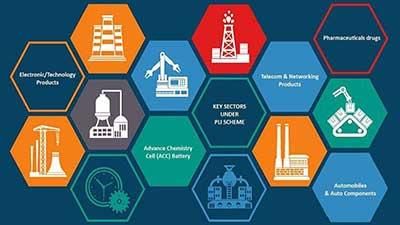
Why in News?
The Union Cabinet Wednesday cleared a revised production linked incentive (PLI) scheme for IT hardware with an outlay of Rs 17,000 crore, more than doubling the budget for the scheme that was first cleared in 2021.
About Production Linked Incentive (PLI) Scheme:
- The PLI scheme was conceived to scale up domestic manufacturing capability, accompanied by higher import substitution and employment generation.
- The government has set aside Rs 1.97 lakh crore under the PLI schemes for various sectors and an additional allocation of Rs 19,500 crore was made towards PLI for solar PV modules in Budget 2022-23.
- Launched in March 2020, the scheme initially targeted three industries:
- Mobile and allied Component Manufacturing
- Electrical Component Manufacturing and
- Medical Devices
Sectors Under PLI Scheme:
- Mobile Manufacturing and Specified Electronic Components
- Critical Key Starting materials/Drug Intermediaries and Active Pharmaceutical Ingredients
- Manufacturing of Medical Devices
- Automobiles and Auto Components
- Pharmaceuticals Drugs
- Specialty Steel
- Telecom and Networking Products
- Electronic/Technology Products
- White Goods (ACs and LEDs)
- Food Products
- Textile Products: MMF segment and technical textiles
- High-efficiency solar PV modules
- Advanced Chemistry Cell (ACC) Battery
- Drones and Drone Components
Advantages:
- It helps to boost domestic manufacturing and reduce the reliance on imports.
- It encourages foreign companies to set up their production units in India.
- More employment opportunities are generated in the manufacturing sector.
- It will boost the growth in GDP and will make it easier for India to effectively penetrate into the global supply chains.
- It will help achieve the aim of ‘Aatmanirbhar Bharat’.
- Integrates India with global markets and boosts exports.
- Gain strategic upper hand by focusing on crucial sectors.
Challenges faced by PLI Scheme
- As per a report, out of the 14 eligible sectors, only two or three were likely to meet their first-year targets under the PLI scheme.
- There is no common set of parameters to understand the value added by companies that have received or are likely to receive incentives under the scheme.
- According to the research, the industries think that further incentives are required to make India more appealing than China and Vietnam.
- The companies need more incentives to run the scheme properly and boost exports.
Way Forward:
The bottlenecks in the PLI scheme are needed to be removed as soon as possible to make India a manufacturing hub and reduce its reliance on China and other nations globally. The government is proactively engaging with all the stakeholders to regularly tweak and update the PLI scheme.
Source: Indian Express
National Medical Commission
Why in News?
The National Medical Commission (NMC) issued a notification that obliges doctors to seek a transfer of their practice license when they move to another state.
About National Medical Commission
- The National Medical Commission Act of 2019 establishes the National Medical Commission (NMC), which is responsible for the creation and regulation of all elements of medical education, practice, and institutions.
- National Medical Commission consists of 25 members including
- The Chairperson, Presidents of Postgraduate Medical Education Boards, and Presidents of Undergraduate Medical Education Boards
- Director General of Indian Council of Medical Research (ICMR)
- Director General of Health Services.
- There are four boards in the National Medical Commission
- Under-Graduate Medical Education Board (UGMEB)- sets norms for undergraduate courses
- Post-Graduate Medical Education Board (PGMEB)- sets norms for post-graduate courses
- Medical Assessment and Rating Board– inspects and rates the medical education institutes
- Ethics and Medical Registration Board– regulates professional conduct of the doctors and registers them
- The draft National Medical Commission (NMC) bill 2022seeks to introduce a fifth autonomous body under the country’s apex medical education regulator to conduct the National Exit Test (NExT)
Source: Indian Express
GS-III
Bhopal’s Voluntary Local Review: A Step towards Localizing SDG’s in India
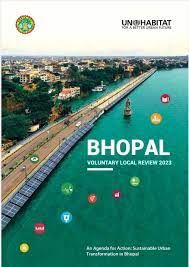
Why in News?
Bhopal, the capital city of Madhya Pradesh, has achieved a significant milestone by becoming the first city in India to join the global movement on localizing the Sustainable Development Goals (SDGs). The city’s Voluntary Local Review (VLR), released recently, highlights Bhopal’s commitment to implementing the SDGs at the local level. This move demonstrates India’s commendable efforts in adopting and localizing the SDGs, with various states and union territories already taking steps in this direction
What is Bhopal’s Voluntary Local Review (VLR)?
- Bhopal’s Voluntary Local Review (VLR) is a comprehensive report released by the city of Bhopal, India, to showcase its progress and initiatives in implementing the Sustainable Development Goals (SDGs) at the local level.
- It provides a detailed analysis of Bhopal’s development projects and their alignment with the SDGs across the three pillars of ‘people,’ ‘planet,’ and ‘prosperity.’
- The report maps these projects to specific SDGs and presents an assessment of the city’s progress, achievements, and challenges in each area.
Features of Bhopal’s VLR
- Collaboration: The VLR is a result of collaboration between the Bhopal Municipal Corporation, UN-Habitat, and a collective of over 23 local stakeholders. This collaborative approach ensures a comprehensive and inclusive representation of Bhopal’s sustainable development efforts.
- Mapping of Developmental Projects: Bhopal’s VLR maps 56 developmental projects to the SDGs across the three pillars of ‘people,’ ‘planet,’ and ‘prosperity.’ This mapping provides a clear understanding of how the city’s initiatives align with the specific goals and targets of the SDGs.
- Focus on Priority Areas: The VLR identifies priority areas for Bhopal, with a particular emphasis on building basic infrastructure and resilience. This highlights the city’s strategic approach in addressing crucial issues and directing efforts towards areas that require immediate attention.
- Quantitative Assessment: Bhopal’s VLR includes an in-depth quantitative assessment of city-level indicators under SDG 11 (Sustainable cities and communities). This assessment evaluates the city’s performance in areas such as solid waste management practices, public transportation, and per capita availability of open spaces.
- Identification of Challenges: The VLR acknowledges the challenges faced by Bhopal in achieving certain SDG targets. It highlights areas where the city needs to work harder, such as adequate shelter provision, air pollution control, city planning capacity, and equitable distribution and accessibility of open spaces. This identification of challenges allows for targeted efforts to address these specific issues.
- Leadership and Stakeholder Engagement: The VLR emphasizes the leadership role of Mayor and efforts in engaging the city’s residents throughout the VLR process. This demonstrates the importance of stakeholder participation and inclusivity in driving sustainable development initiatives.
- Localized Approach: Bhopal’s VLR recognizes the unique local context and capacity constraints faced by Indian cities. It acknowledges that a comprehensive VLR covering all SDGs may be challenging for cities with limited resources and data availability. Therefore, the VLR allows for flexibility, enabling cities to choose specific SDGs for a detailed review and adapt national indicators to reflect the city’s local realities.
The Importance of Localizing Sustainable Development Goals (SDGs)
- Contextualization: Localizing the SDGs allows cities, regions, and communities to adapt the global goals to their specific local contexts. Each locality has unique challenges, priorities, and resources. By localizing the SDGs, governments, organizations, and stakeholders can tailor strategies and interventions to address the specific needs of their communities, making them more relevant and effective.
- Proximity to the People: Local governments and communities are closest to the people they serve. They have a better understanding of the local needs, aspirations, and realities of their residents. By localizing the SDGs, decision-making processes become more participatory and inclusive, ensuring that the voices and perspectives of the local population are taken into account.
- Holistic Approach: The SDGs address a broad range of interconnected social, economic, and environmental challenges. Localizing the goals allows for a holistic approach to sustainable development, considering the interdependencies and synergies between different sectors and issues. It encourages integrated and comprehensive strategies that tackle multiple challenges simultaneously, leading to more sustainable and equitable outcomes.
- Collaboration and Partnership: Localizing the SDGs fosters collaboration and partnership among various stakeholders at the local level. Governments, civil society organizations, businesses, academia, and citizens can come together to work towards common goals, leveraging their respective strengths, expertise, and resources. This multi-stakeholder approach promotes collective action, knowledge-sharing, and innovation, leading to more effective and sustainable solutions.
- Innovation and Experimentation: Localizing the SDGs encourages innovation and experimentation. Local governments and communities can explore new approaches, policies, and practices to address complex challenges. They can pilot innovative solutions, learn from successes and failures, and share their experiences with other localities, contributing to a global knowledge exchange and learning process.
- Monitoring and Accountability: Localizing the SDGs facilitates monitoring and accountability mechanisms at the local level. By setting local targets, indicators, and progress tracking systems, governments and stakeholders can monitor the implementation of the goals and measure their impact on the ground. This localized monitoring promotes transparency, accountability, and data-driven decision-making, ensuring that progress towards sustainable development is effectively measured and evaluated.
- Global Impact: While the SDGs are a global agenda, their achievement ultimately depends on action at the local level. Localizing the goals is essential for aggregating local actions and initiatives to create significant impact at the global scale. When cities, regions, and communities across the world localize the SDGs, they contribute to the collective effort of achieving sustainable development globally.
Notable examples where cities and local governments have successfully localized the SDGs
- New York City, United States: New York City developed an SDG framework called “OneNYC” to align its local goals and initiatives with the SDGs. The framework focuses on various areas, including reducing poverty, promoting sustainability, addressing climate change, and improving quality of life.
- Bristol, United Kingdom: Bristol was one of the first cities to create a localized SDG plan known as the “Bristol One City Plan.” The plan integrates the SDGs into the city’s strategic priorities, such as reducing inequality, promoting sustainable economic growth, and addressing climate change.
- Kitakyushu, Japan: Kitakyushu, a city in Japan, has implemented the “Kitakyushu SDGs City Vision” to align its local strategies with the SDGs. The vision focuses on areas such as resource efficiency, waste management, renewable energy, and sustainable urban development. Kitakyushu’s successful experience in environmental sustainability has made it a global leader in eco-industrial development.
- Medellín, Colombia: Medellín has embraced the SDGs through its “Medellín Sustainable Development Goals 2030” strategy. The city has aligned its policies, programs, and projects with the SDGs, focusing on social inclusion, education, public transportation, urban development, and reducing violence. Medellín’s approach highlights the importance of social innovation and participatory governance in achieving sustainable development.
- Barcelona, Spain: Barcelona has integrated the SDGs into its urban development strategy known as “Barcelona City Council 2030 Agenda.” The city’s approach emphasizes social justice, gender equality, environmental sustainability, and inclusive economic growth.
Opportunities for Indian cities in localizing the SDGs
- Tailoring to Local Context: Localizing the SDGs allows Indian cities to adapt the global goals to their specific needs and realities. By identifying local priorities and strategies, cities can address issues such as poverty, education, healthcare, infrastructure, environmental sustainability, and urban planning in a manner that is most relevant to their local populations.
- Leveraging Local Innovation: Localizing the SDGs provides an opportunity for cities to leverage their local innovation ecosystems to develop creative solutions to sustainable development challenges. By fostering collaboration between local businesses, startups, research institutions, and communities, cities can drive innovation and implement sustainable practices that can have a transformative impact.
- Enhancing Local Governance and Participation: Localizing the SDGs empowers local governments to strengthen their governance systems and promote participatory decision-making. It encourages local authorities to engage citizens, civil society organizations, and other stakeholders in the planning, implementation, and monitoring of sustainable development initiatives. This participatory approach can lead to more inclusive and effective governance, as well as increased accountability and transparency.
- Sharing Best Practices and Learning: By sharing successful initiatives, innovative approaches, and lessons learned, cities can create a knowledge-sharing network, fostering collaboration and replication of effective strategies. This knowledge exchange can lead to improved policy-making, enhanced capacity-building, and accelerated progress towards the SDGs.
- Attracting Investments and Partnerships: Localizing the SDGs can help Indian cities attract investments, forge partnerships, and access funding opportunities. By demonstrating their commitment to sustainable development and showcasing their achievements, cities can attract investors, businesses, and development organizations that are aligned with the SDGs. Collaborative partnerships can bring in resources, expertise, and technical assistance to support the implementation of sustainable projects and initiatives.
- Global Recognition and Collaboration: Localizing the SDGs positions Indian cities as active participants in the global sustainable development agenda. It offers an opportunity to gain global recognition for their efforts and innovations. By actively engaging with international platforms, networks, and initiatives focused on sustainable urban development, Indian cities can collaborate with other cities, share experiences, and contribute to global efforts in achieving the SDGs
Conclusion
Bhopal’s pioneering VLR sets an inspiring precedent for other Indian cities to embrace localisation and actively contribute to the SDGs. Localizing the SDGs provides Indian cities with an invaluable opportunity to address local challenges, tailor strategies to their specific contexts, and engage stakeholders in decision-making processes. By following Bhopal’s lead Indian cities can create a more inclusive, resilient, and prosperous future for their residents and leave a lasting impact on the global map of sustainable development.
Source: The Hindu
NIA’s Operation Dhvast
Why in News?
The National Investigation Agency (NIA) has arrested three persons in connection with the raids conducted as part of a nationwide drive codenamed ‘Operation Dhvast’, in the terrorist-gangster-drug smugglers network cases.
Major Points
- The latest searches were part of the continuing NIA action against terror networks as well as their funding and support infrastructure, with respect to which it has been probing three cases since August 2022.
- The cases are connected with conspiracies related to targeted killings, terror funding of pro-Khalistan outfits, extortion, etc.
About National Investigation Agency (NIA)
- It was constituted in the wake of the 26/11 Mumbai terror attack in November 2008 and started its functioning in 2009.
- It is a central agency mandated to investigate all the offences affecting the sovereignty, security and integrity of India, friendly relations with foreign states, and the offences under the statutory laws enacted to implement international treaties, agreements, conventions and resolutions of the United Nations, its agencies and other international organisations.
- These include terror acts and their possible links with crimes like smuggling of arms, drugs and fake Indian currency and infiltration from across the borders.
- The agency has the power to search, seize, arrest and prosecute those involved in such offences.
- The law under which the agency operates extends to the whole of India and also applies to Indian citizens outside the country.
Jurisdiction
- The law under which the agency operates extends to
- the whole of India and also applies to Indian citizens outside the country;
- persons in the service of the government wherever they are posted;
- persons on ships and aircraft registered in India wherever they may be;
- persons who commit a scheduled offence beyond India against the Indian citizen or affect the interest of India.
Amendments
- The NIA Act was amended in the year 2019 to enlarge the mandate of the NIA by the inclusion of offences related to human trafficking, manufacture/sale of prohibited arms, cyber-terrorism and offences under the Explosive Substances Act, 1908 and expanded its jurisdiction beyond India.
- Unlawful Activities (Prevention) Act, 1967 was amended in the year 2019 to inter-alia empower the Director General (DG), of the NIA to seize/attach the properties related to proceeds of terrorism in cases being investigated by the NIA.
Source: The Hindu
Sendai Framework for Disaster Risk Reduction: It is time to pay attention to funding disaster risk reduction
Why in News?
What is the Sendai Framework for Disaster Risk Reduction?India at a meeting to review the Sendai Framework for Disaster Risk Reduction (DRR), highlighted the need to pay attention to funding DRR and developing early warning systems, as the world has focused on financing disaster response so far.
- The Sendai Framework (2015–2030) is an international document that was adopted by the UN member states at the 3rd World Conference on Disaster Risk Reduction held in Sendai, Japan.
- Endorsed by the UN General Assembly in June 2015, it is the successor agreement to the Hyogo Framework for Action (2005–2015) - the most encompassing international accord to date on DRR.
- It works hand in hand with the other 2030 Agenda agreements, including
- The Paris Agreement on Climate Change,
- The Addis Ababa Action Agenda on Financing for Development,
- The New Urban Agenda, and
- The Sustainable Development Goals.
- It recognises that the State has the primary role to reduce disaster risk but that responsibility should be shared with other stakeholders - local government, the private sector, etc.
Priority Areas and Global Targets under the Sendai Framework:
- Understanding disaster risk;
- Strengthening disaster risk governance to manage disaster risk;
- Investing in disaster risk reduction for resilience;
- Enhancing disaster preparedness for effective response and to "BuildingBack Better" in recovery, rehabilitation and reconstruction.
- About the meeting:
- Convened by the President of the General Assembly, the High-Level Meeting (HLM) on the Midterm Review of the implementation of the Sendai Framework took place at the UN Headquarters in New York.
- The HLM provides a platform for Member States and other stakeholders to examine emerging issues since 2015, identify course corrections and realise the outcomes and goals of the Sendai Framework.
- The Indian delegation emphasised:
- The issue of DRR is getting the requisite attention in the global policy discourse as both G20 and G7 have accorded priority to this issue.
- India accords high importance to the issue and brought landmark changes in its financing architecture.
- The state and local governments have access to about $6 billion for disaster risk mitigation over five years (2021-2025).
- This is in addition to a resource of $23 billion meant for preparedness, response and recovery.
- Achievements of India: Loss of lives from cyclones reduced to less than 2% and is now developing ambitious mitigation programmes to reduce the risk of losses from other hazards - landslides, forest fire, heatwaves, lightning, etc.
- Global initiative:
- The UN Secretary General launched the initiative - ‘Early Warning for All by 2027’.
- G20, under India’s Presidency in 2023, has taken an important step to establish a Working Group on Disaster Risk Reduction.
- Recommendations by India:
- To evolve a financial architecture that can address the entire spectrum of DRR and specify the role of the State in strengthening early warning systems in times of disaster.
- To initiate multi-country cooperation, including their respective roles in increasing access to hazard and risk information as well as enhancing disaster risk governance.
Source: Indian Express
|
38 videos|5288 docs|1117 tests
|


